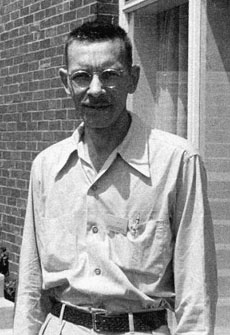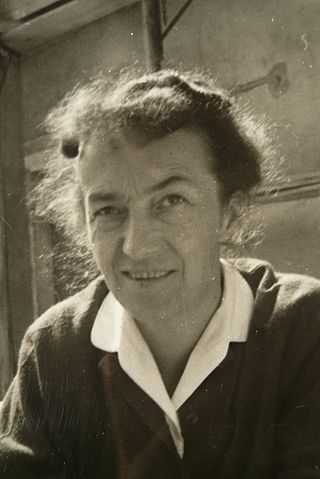
Deoxyribonucleic acid is a polymer composed of two polynucleotide chains that coil around each other to form a double helix. The polymer carries genetic instructions for the development, functioning, growth and reproduction of all known organisms and many viruses. DNA and ribonucleic acid (RNA) are nucleic acids. Alongside proteins, lipids and complex carbohydrates (polysaccharides), nucleic acids are one of the four major types of macromolecules that are essential for all known forms of life.

Enterobacteria phage λ is a bacterial virus, or bacteriophage, that infects the bacterial species Escherichia coli. It was discovered by Esther Lederberg in 1950. The wild type of this virus has a temperate life cycle that allows it to either reside within the genome of its host through lysogeny or enter into a lytic phase, during which it kills and lyses the cell to produce offspring. Lambda strains, mutated at specific sites, are unable to lysogenize cells; instead, they grow and enter the lytic cycle after superinfecting an already lysogenized cell.
Molecular biology is a branch of biology that seeks to understand the molecular basis of biological activity in and between cells, including biomolecular synthesis, modification, mechanisms, and interactions.
Semiconservative replication describes the mechanism of DNA replication in all known cells. DNA replication occurs on multiple origins of replication along the DNA template strands. As the DNA double helix is unwound by helicase, replication occurs separately on each template strand in antiparallel directions. This process is known as semi-conservative replication because two copies of the original DNA molecule are produced, each copy conserving (replicating) the information from one half of the original DNA molecule. Each copy contains one original strand and one newly synthesized strand. The structure of DNA suggested that each strand of the double helix would serve as a template for synthesis of a new strand. It was not known how newly synthesized strands combined with template strands to form two double helical DNA molecules.
The Meselson–Stahl experiment is an experiment by Matthew Meselson and Franklin Stahl in 1958 which supported Watson and Crick's hypothesis that DNA replication was semiconservative. In semiconservative replication, when the double-stranded DNA helix is replicated, each of the two new double-stranded DNA helices consisted of one strand from the original helix and one newly synthesized. It has been called "the most beautiful experiment in biology". Meselson and Stahl decided the best way to trace the parent DNA would be to tag them by changing one of its atoms. Since nitrogen is present in all of the DNA bases, they generated parent DNA containing a heavier isotope of nitrogen than would be present naturally. This altered mass allowed them to determine how much of the parent DNA was present in the DNA after successive cycles of replication.

Salvador Edward Luria was an Italian microbiologist, later a naturalized U.S. citizen. He won the Nobel Prize in Physiology or Medicine in 1969, with Max Delbrück and Alfred Hershey, for their discoveries on the replication mechanism and the genetic structure of viruses. Salvador Luria also showed that bacterial resistance to viruses (phages) is genetically inherited.

Escherichia virus T4 is a species of bacteriophages that infect Escherichia coli bacteria. It is a double-stranded DNA virus in the subfamily Tevenvirinae from the family Myoviridae. T4 is capable of undergoing only a lytic life cycle and not the lysogenic life cycle. The species was formerly named T-even bacteriophage, a name which also encompasses, among other strains, Enterobacteria phage T2, Enterobacteria phage T4 and Enterobacteria phage T6.

Alfred Day Hershey was an American Nobel Prize–winning bacteriologist and geneticist.

Obaid Siddiqi FRS was an Indian National Research Professor and the Founder-Director of the Tata Institute of Fundamental Research (TIFR) National Center for Biological Sciences. He made seminal contributions to the field of behavioural neurogenetics using the genetics and neurobiology of Drosophila.

Franklin (Frank) William Stahl is an American molecular biologist and geneticist. With Matthew Meselson, Stahl conducted the famous Meselson-Stahl experiment showing that DNA is replicated by a semiconservative mechanism, meaning that each strand of the DNA serves as a template for production of a new strand.

Ethyl methanesulfonate (EMS) is an organosulfur compound with the formula CH3SO3C2H5. It is the ethyl ester of methanesulfonic acid. A colorless liquid, it is classified as an alkylating agent. EMS is the most commonly used chemical mutagen in experimental genetics. Mutations induced by EMS exposure can then be studied in genetic screens or other assays.

Bruce Michael Alberts is an American biochemist and the Emeritus Chancellor’s Leadership Chair in Biochemistry and Biophysics for Science and Education at the University of California, San Francisco. He has done important work studying the protein complexes which enable chromosome replication when living cells divide. He is known as an original author of the "canonical, influential, and best-selling scientific textbook" Molecular Biology of the Cell, as an Editor-in-Chief of Science magazine. He was awarded the National Medal of Science for "intellectual leadership and experimental innovation in the field of DNA replication, and for unparalleled dedication to improving science education and promoting science-based public policy" in 2014.
The history of molecular biology begins in the 1930s with the convergence of various, previously distinct biological and physical disciplines: biochemistry, genetics, microbiology, virology and physics. With the hope of understanding life at its most fundamental level, numerous physicists and chemists also took an interest in what would become molecular biology.

René Thomas (14 May 1928 - 9 January 2017 was a Belgian scientist. His research included DNA biochemistry and biophysics, genetics, mathematical biology, and finally dynamical systems. He devoted his life to the deciphering of key logical principles at the basis of the behaviour of biological systems, and more generally to the generation of complex dynamical behaviour. He was professor and laboratory head at the Université Libre de Bruxelles, and taught and inspired several generations of researchers.
The phage group was an informal network of biologists centered on Max Delbrück that contributed heavily to bacterial genetics and the origins of molecular biology in the mid-20th century. The phage group takes its name from bacteriophages, the bacteria-infecting viruses that the group used as experimental model organisms. In addition to Delbrück, important scientists associated with the phage group include: Salvador Luria, Alfred Hershey, Seymour Benzer, Charles Steinberg, Gunther Stent, James D. Watson, Frank Stahl, and Renato Dulbecco.
The history of genetics can be represented on a timeline of events from the earliest work in the 1850s, to the DNA era starting in the 1940s, and the genomics era beginning in the 1970s.
Gisela Mosig was a German-American molecular biologist best known for her work with enterobacteria phage T4. She was among the first investigators to recognize the importance of recombination intermediates in establishing new DNA replication forks, a fundamental process in DNA replication.

Grete Kellenberger-Gujer (1919–2011) was a Swiss molecular biologist known for her discoveries on genetic recombination and restriction modification system of DNA. She was a pioneer in the genetic analysis of bacteriophages and contributed to the early development of molecular biology.
Frederic Lawrence Holmes was an American historian of science, specifically for chemistry, medicine and biology.
Charles 'Charley' M. Steinberg was an immunobiologist and permanent member of the Basel Institute for Immunology. He was a former student of Max Delbrück. Notably he hosted Richard Feynman at Caltech when Feynman studied molecular biology, leading Feynman to remark that Charlie was “...the smartest guy I know”. He was instrumental in the discovery of V(D)J recombination, bacteriophage genetics as part of the phage group and co-discoverer of the amber-mutant of the T4 bacteriophage that led to the recognition of stop codons.











